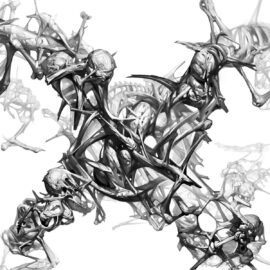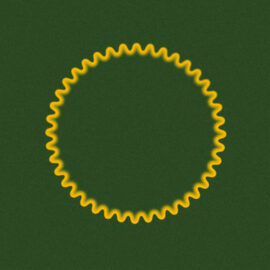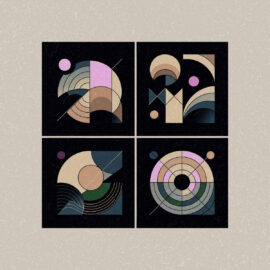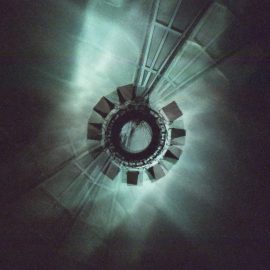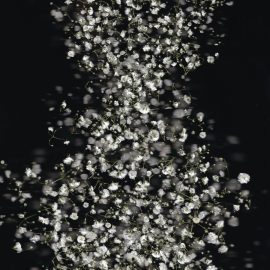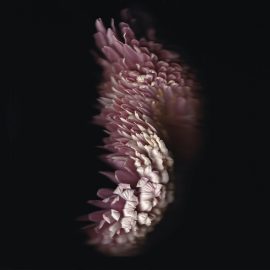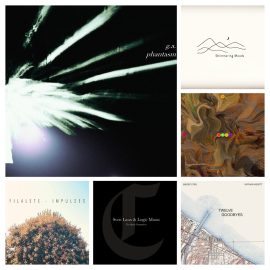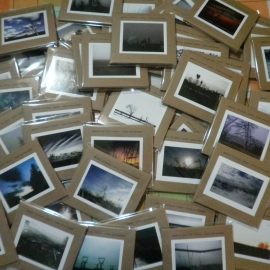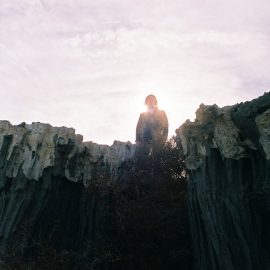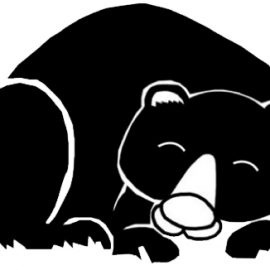
Interview with Richard Chartier
Hey Richard, thank you for joining us. What did you do this past weekend?
this past weekend i bought a huge mid century executive desk designed by Jens Risom for my studio/office. and my partner Robert and i went to see the new ColorForms exhibit and Joseph Albers Retrospective at the Hirshhorn Museum and Sculpture Garden. We also celebrated the great news that i had been awarded the Smithsonian Institution Artist Research Fellowship to explore/record the Museum of Natural History’s collection of 19th Century acoustic apparatus for scientific demonstration.
Let’s start at the beginning. How did you first get into music?
one of the first records i remember playing (which belonged to my parents) was Kraftwerk’s Autobahn. i am not sure how it got there as it was so different from al the other records they owned.
What about the first time when you started producing? What did you use?
i think my first synthesizer was a Yamaha DX100 this was probably in 1985? i did not formally start making “serious” electronic music until 1989
Do you remember your very first release? What did it feel like, holding your own music in your hands?
My first formal release was the CD “Direct.Incidental.Consequential” on Howard Stelzer’s Intransitive Records. I was doing the package, identity design for Howard and ended up sending him some sound works i had been working on in 1998, as well as early stuff from 1990-92. It was a wonderful feeling to have that first cd come out. I never thought i would release it, and to be honest i wasnt sure if i would release anything else.
In 1999 you released an album with Taylor Deupree, titled SPEC. How did you meet Taylor?
I contacted several artists whose work i had been enjoying or had influenced me. Among some of the artists I sent the intransitive CD to: Taylor Deupree, Steve Roden, Chris and Cosey, CoH, Matmos. All of whom i became friends with. I began talking with Taylor Deupree on a regular basis and ended up meeting with him at his home and studio when i was in NY one weekend. We shared a lot of common interests and goals, especially when it came to music, aesthetics, architecture. oh and, he had never met anyone else who loved the band Pink Industry.
Tell us about your first sound installation. How did that come about?
my first sound installation was a project for a multi-disciplinary art class at my university. i had found a strange storage area in one of the old buildings where the painting classes were held. in was a corridor in the basement that was probably 40 feet long and about 8 feet wide. it was originally the entrance to a bomb shelter. this long hallway was very very dark, pitch black about 20 feet in and ended at a T. There were two space on either side which were the sealed off stairwells to the bomb shelter. In each of these alcoves i had a long drone piece eminatting from an amplified CD. the sound would the back wall and project backwards into the hallway. the 2 pieces were inverted so they created an out of phase . Along with the pitch black darkness the effect of the distant audio being out of phase it was very disorienting. unfortunately it could not be shown again due to potential lawsuits etc.
Where do you think the line dissolves between creating albums and sound art?
musicality? an “album” is merely a form that sound art can take.
And when you create music today, do you produce an album to be listened to at home, or are you creating sound art intended to be showcased at an exhibit, that may eventually be documented by a release on your label?
each project is very distinct. installation work on multiple speakers or dealing with loop cycles can’t truly be replicated/reduced onto a CD. the installation work is very much about the body within a space.
You’ve collaborated with many artists, including the above mentioned Taylor Deupree, William Basinski, and COH. What was your most memorable partnership?
They are all very unique and different experiences, because each of the artists i have worked with are very distinct. i have always believed that the best collaborations are those where the listener cannot hear each artist distinctly. I find that working collaboratively i tend to take on (or perhaps learn from) certain characteristics of the other artist in the project. I really enjoy working with Asmus Tietchens. I have a very great respect for him and his long history of works and he is an incredibly kind man. We met at the Observatori Festival in Valencia, Spain in 2003. During one of our conversations he said that listening to Ryoji Ikeda, I, and (if i remember correctly) Steve Roden had really inspired him to create new work such as the Mengen series. That was a profound moment for me, having someone as iconic and brilliant as Asmus say that i had in any way influenced him.
Is there anyone that you would love to work with in the future?
I would love to do something with AGF (but i haven’t asked her yet… maybe i will now). I love what she does sonically with lyrics and vocals. I have approached creating something with Robert Curgenven, because i love the nature of his process and sound. My friend Kid Congo Powers (guitarist extra-ordinaire from The Cramps, Gun Club, Nick Cave and the Bad Seeds) are trying to figure out how to begin our collaboration. (he is on tour a lot) I look forward to that one as i think it will be VERY strange combination.
At which point did you decide that you wanted to have your own label?
Well, it all came about because of my work “series.” I had sent it off to Ritornell/Mille Plateaux and Raster-Noton. Eckhard Ehlers and Olaf Bender both responded that while they liked it, it was just too minimal (which i thought was funny). As i thought more and more and discussed the recording with Taylor Deupree (and after us both deciding it was too minimal for 12k as well), he suggested “why not just start a new label, or sub label of 12k?” and so i did, i already had some demos from other artists who i was interested in having on 12k that were also in that same vein. LINE was born. right after we had made all the plans and finalized the logo etc etc, Olaf Bender of Raster-Noton wrote me and said he had finally listened to it on a very high quality studio and finally ‘got it’ and wanted to release it. ooops too late.
Where did the name LINE come from?
a line is just the shortest distance between two points. it was a very fitting name for the type of work that LINE would release.
Tell us the intended vision behind your label, when you first created it. Has that purpose changed throughout the years?
the original mission was to document digital minimalist sound art and installations. this has evolved over the past decade to include audio/video works on DVD, and some not so minimal works, like Mark Fell’s first LINE CD and Chessmachine. Also acoustic works have come into the mix with Doublends Vert and Janek Schaefer’s releases.
How would you describe the relationship between 12k and LINE?
siblings? Taylor Deupree is 12k and i am LINE. Although we have always bounced off each other ideas regarding cover designs, artists, projects etc about both labels. Taylor is also the businessman. I am the “artistic director” of LINE. I convinced Taylor way back to create a uniform template for the releases. I think his designs and his photography for 12k have made each release beautiful and special.
And what is 3particles?
well i didn’t buy richardchartier.com and by the time i had actually made a name for myself it was taken by a Canadian real estate agent. electrons, muons, and tau are the 3 primary particles that make up an atom. it was a name of a piece i did and it just stuck.
You’ve got an amazing catalog of releases on LINE, including works by Alva Noto, Bernhard Gunter, Steve Roden, Christopher Willits et al. Are there any ones that you are especially proud of?
Bernhard Gunters 4CD “monochrome” series, the works by Asmus Tietchens, Mark Fell’s “Ten types of Elsewhere” stand out just off the top of my head. All the LINE releases are very distinct to me, each with its own special qualities. I love Robert Curgenven’s “Oltre” , i have been listening to it on repeat.
And is there anyone in particular that you would be honored to sign?
hmmmmm off the top of my head i can only think of Chris Watson.
How do you decide on which artists and albums get released on your label?
its very subjective.
What advice would you give to artists interested in getting their own record deal?
be confident, present your work well. don’t send messy demos. and don’t bombard labels with excessive emails and packages. and most especially DON’T contact them through myspace.
In 2008 LINE had five album releases. In 2009, four. And it looks like for this year you have already scheduled four albums. Can you talk a little about the economics of running a label?
I am not involved deeply in the day to day economics of the label. both 12k and LINE are labors of love for Taylor and myself.
What are some of the most difficult aspects of running your own label?
for me, its balancing work on the label with my own work and projects. its a lot of shifting gears.
And what are the rewarding ones?
i was just rearranging my studio/office recently and laid out all of the LINE releases on the floor. it was quite impressive. i have now put a whole decade of my life into LINE. so the most rewarding part is the final product and having been a meaningful part in having these artists and these works heard.
Do you have any advice for someone who wants to kick off their own label?
start honest and professional and stay honest and professional
What’s next for LINE?
the upcoming new releases are by Lovesliescrushing, Alva Noto, Yann Novak…… more surprises to come….
Thank you for your time. Any last words for the readers of Headphone Commute?
keep listening…

